山坡上的Bunkie住宅作为分散在四个地块的度假屋系列中面积最小的 一栋,为Muskoka的家庭旅客提供了喘息的空间。Bunkie住宅隐藏在陡峭斜坡顶部的树林中,旨在提供一个安静的空间,远离了斜坡下其他多代家庭小屋的活动日常。
The smallest in a collection of cabins scattered across four family properties, a Bunkie on the Hill serves as a space of respite for a family-oriented client in Muskoka. The Bunkie, tucked into the trees at the top of a steep slope, was designed to provide a quiet space away from the action of the multi-generational family cottages below.
▼项目鸟瞰,aerial view of the project© Riley Snelling


▼顶视图,top view© Riley Snelling
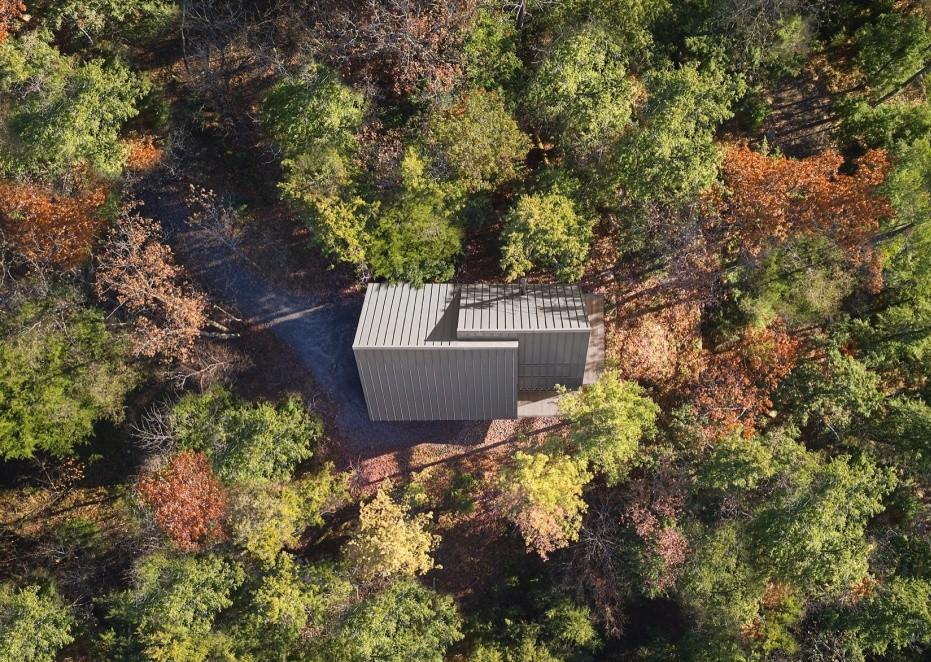
对传统A型框架形状的当代诠释唤起了典型的森林小屋的感觉,而高耸的坡屋顶带来了不同的体量形式。相叠交错的屋顶设计让人联想到周围景观中重叠的岩石层,相交的山墙为屋顶体量分开的位置创造了开窗的机会。这些开窗将一侧树林以及另一侧下方的湖泊景观引入室内,同时也为小屋内部引入了充足的自然光线,反射出尖锐的屋顶角度,创造出戏剧性的线条和阴影。
▼分析图,analysis diagram© Dubbeldam Architecture Design

A contemporary interpretation of the traditional A-frame shape evokes the quintessential cabin in the woods, differentiated by shifted roof volumes. Reminiscent of the overlapping layers of rock in the surrounding landscape, the split roof design features two intersecting gables that create opportunities for window openings where the roof volumes separate. These geometric windows allow for curated views of the treetops on one side and lake below on the other and invite natural light to flood the interior of the cabin, reflecting off the sharp roof angles and creating dramatic lines and shadows.
▼远景,viewing the house at distance© Riley Snelling
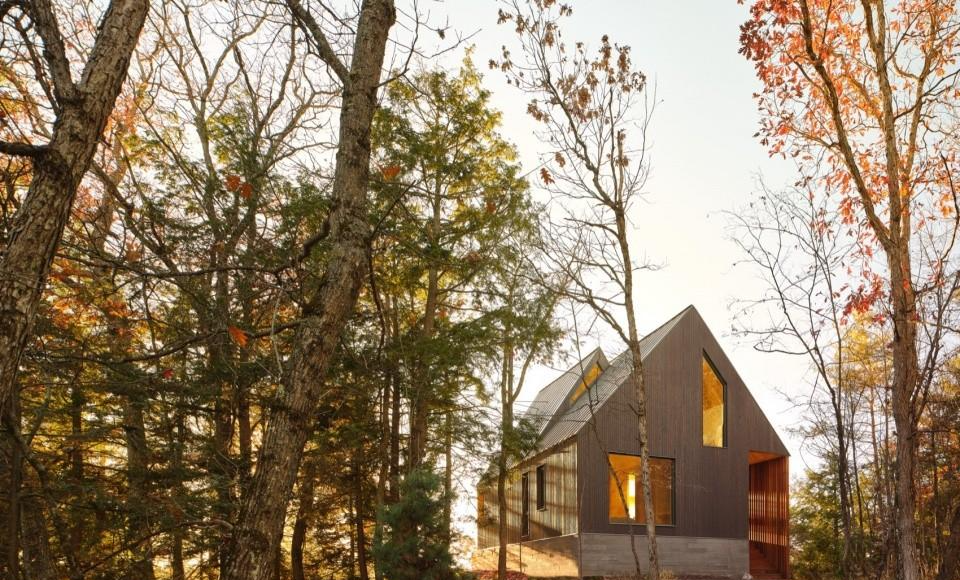
▼项目外观概览,exterior views of the project© Riley Snelling


小屋的分离且交叠的屋顶设计也在两侧产生了不同的立面 —— 面向湖泊的高而窄的玻璃立面,以及面向森林的更宽,更封闭的立面,凹进的入口凉廊则位于住宅的西侧。住宅主入口位于侧立面中部,前部为凉廊走道与板条雪松屏风,凉廊的两端则构成了望向周围树林的景观画框。雪松屏风被不断变化的西光所激活,格栅过滤了光线,产生了动态的光影效果,增强了材料的丰富性,为游客创造了引人入胜的体验。
The cabin’s split roof design also generates distinct elevations on either side – a tall, narrow, glazed facade facing the lake, and a wider, more opaque facing the forest, with a cut out for a covered entrance on the west side. Located midway along the side façade, the cabin’s entrance features a walkway with a slatted cedar screen on one side which echoes the tree trunks seen through framed views at each end. The cedar slats are animated by the ever-changing west light that filters through its openings, producing a dynamic interplay of light and shadows that enhance the richness of the material and creating an engaging experience for visitors.
▼侧立面,profile© Riley Snelling
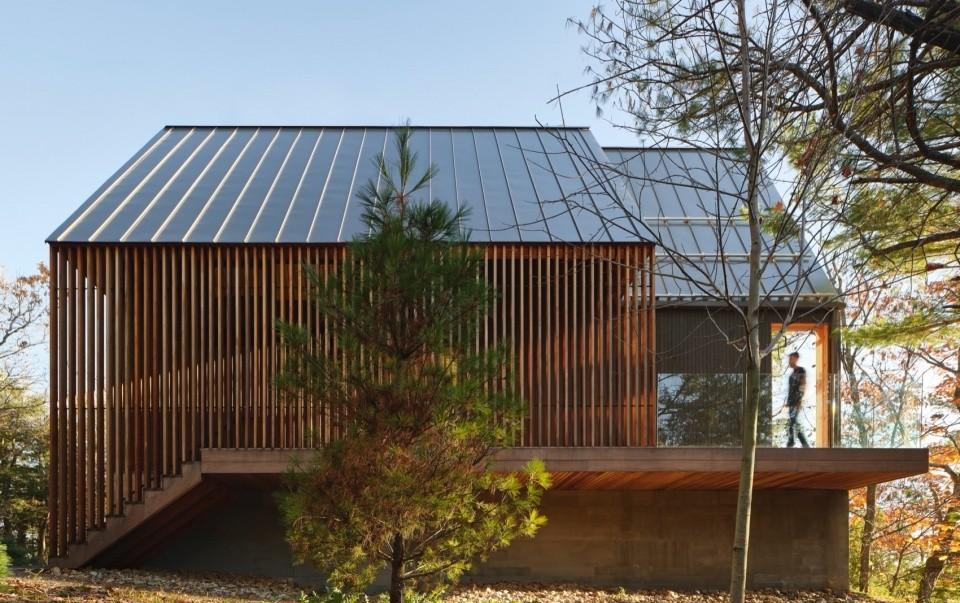
▼入口与凉廊,entrance and porch© Riley Snelling


Bunkie住宅面积虽小,但空间非常具有功能性。小角落里包含了存储架或内置长凳。每处室内空间都经过精心的设计,形成了周围森林或下面湖泊的景观画框。上层阁楼区域设置了内置桌子,可以俯瞰到一层的起居空间和远处广阔的湖泊,此外,还提供了一处额外的睡眠空间。卧室位于建筑后部,大面积的开窗让居住者欣赏到森林的美景。
The Bunkie’s interior is functional despite its compact size. Small nooks throughout contain storage shelves or built-in benches. Each interior space is designed to offer framed views of the surrounding forest or the lake below. The upper loft area includes a built-in desk with a view down to the living space on the first level and the vast lake beyond, as well as an extra space for sleeping. The bedroom is located at the rear and features a large window that offers immersive views of the forest.
▼室内概览,overall of interior© Riley Snelling
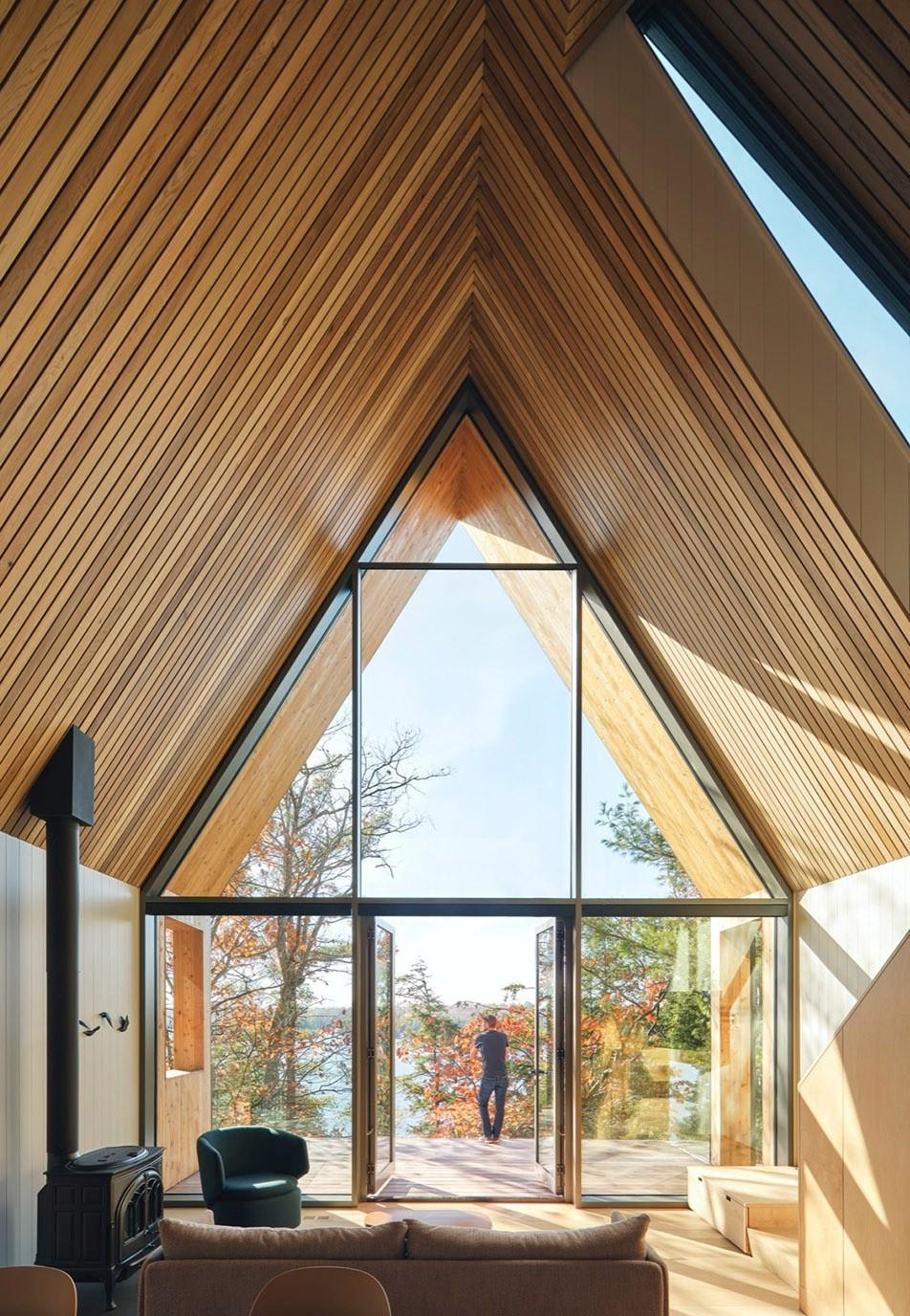
▼客厅,living room© Riley Snelling
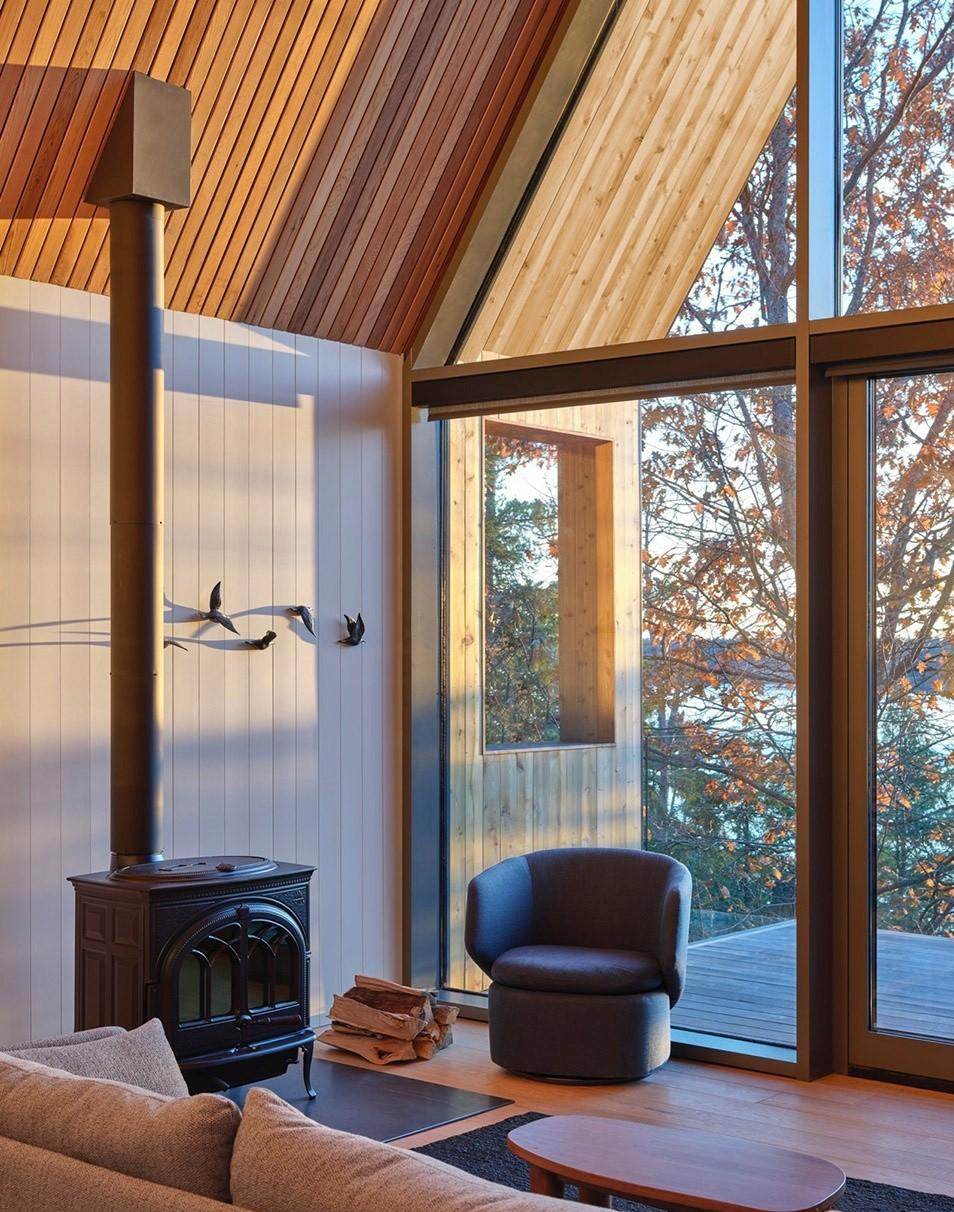
▼夹层,mezzanine© Riley Snelling

▼玻璃山墙,glazing gable wall© Riley Snelling

▼开窗细部,details of the opening© Riley Snelling


天然材料的选择呼应了Bunkie住宅周围的乡村景观。灰色的木壁板与天然雪松天花板形成鲜明对比,坐落在裸露板状混凝土基础上的雪松屏风构成了入口凉廊。室内材料包括橡木地板、枫木胶合板和雪松包层,深色木炭窗框、灰色石材柜台和色彩鲜明的家具。不同的木材种类被用来区分空间中的不同平面 —— 白色墙板定义了外墙内侧,而隔墙则采用了枫木胶合板,天花板则采用了西部红雪松板条
Natural materials were chosen to complement the rustic landscape that surrounds the Bunkie. Greyed wood siding contrasts the natural cedar soffits and screen that frames the entrance, sitting atop the raw, board-formed concrete base. Interior materials include oak flooring, maple plywood, and cedar cladding, grounded by dark charcoal window frames, grey stone counters, and furniture that offers moments of colour. A variety of wood species was used to differentiate the various planes in the space – white wallboard defines the interior perimeter walls, internal partitions are clad in maple plywood, and the ceiling is delineated by Western red cedar slats.
▼室内全览,overall of interior© Riley Snelling

▼楼梯与集成壁橱,staircase and integrated closet© Riley Snelling

▼厨房餐厅,kitchen-dining© Riley Snelling

可持续材料和施工方法对客户来说非常重要。加厚的外墙作为被动隔热层 —— R值超过了45,此外还设有三层玻璃窗,这些策略大大降低了下部空间供暖系统所消耗的能源。尽管使用了钢框架,但还是使用了组合板梁来消除任何热桥效应。为了避免爆破的需要,Bunkie被抬高到平地以上,它的基础建在天然岩石的顶部,使结构可以轻松地坐落于景观上。
Sustainable materials and construction methods were important to the client. The exterior walls have been thickened to serve as a passive insulator – boasting an R-value of over 45 – and include triple-glazed windows, making it possible to use a minimal heating system in the crawl space below. Flitch beams were utilized to eliminate any thermal bridges, despite the use of steel framing. To avoid the need for blasting, the Bunkie was raised above grade and its foundation constructed on top of the natural rock contours, allowing the structure to sit lightly on the landscape.
▼夹层额外卧室空间,extra bedroom on the mezzanine© Riley Snelling
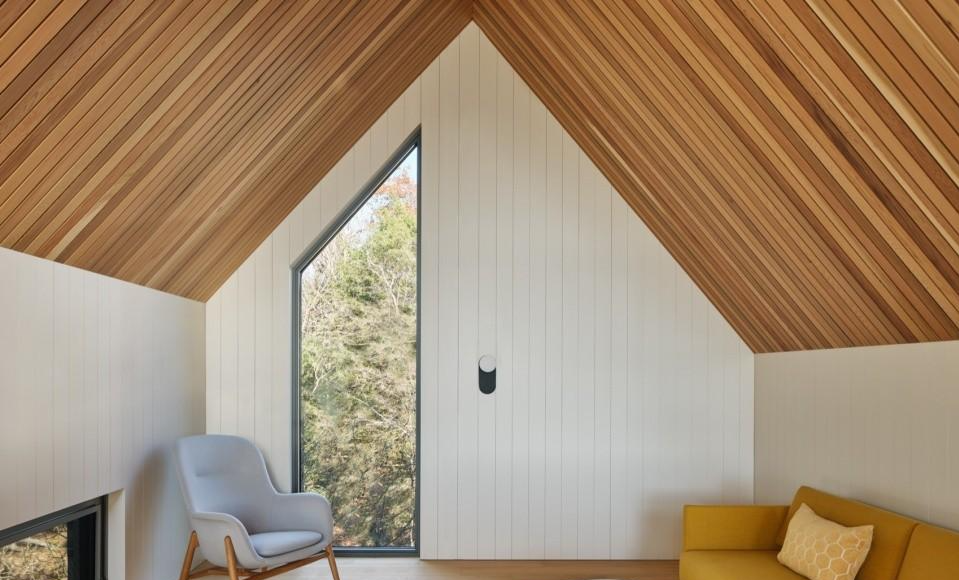
▼卧室,bedroom© Riley Snelling
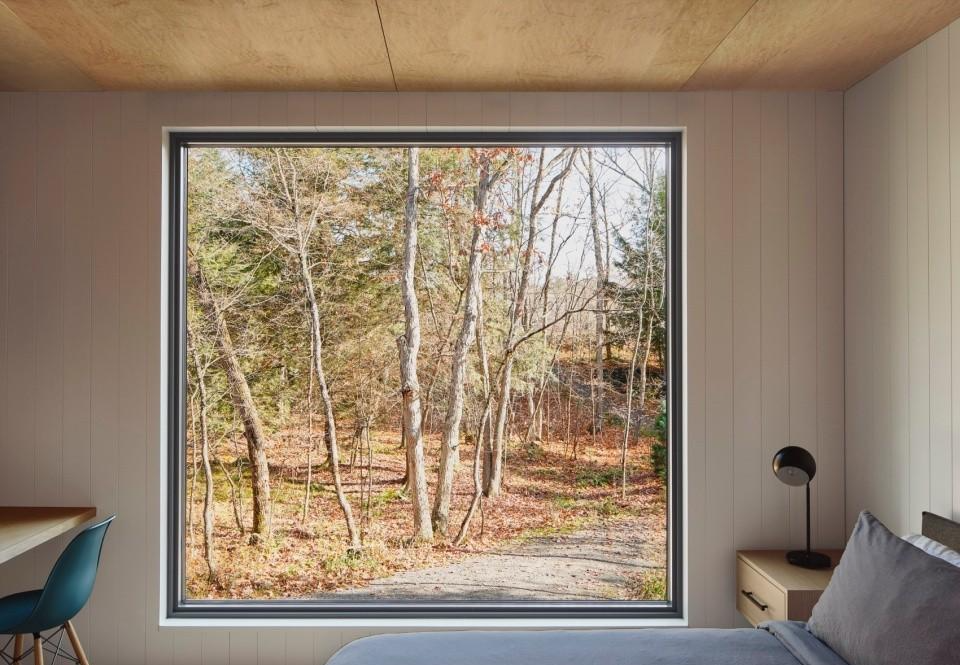
▼浴室,bathroom© Riley Snelling

项目中所采用的木制品都得到了FSC认证,少数管道和灯具都是低流量和低能耗的。天然的材料会随着时间的推移产生微妙的变化,使Bunkie住宅重新融入了周围的森林坡地环境中。
Wood products used are FSC-rated and the few plumbing and light fixtures are low flow and low energy. Any patina of materials over time is intentional: as time passes the Bunkie blends back into its forested hill setting.
▼夜景鸟瞰,aerial view at night© Riley Snelling

▼外观夜景,exterior view at night© Riley Snelling

▼山墙夜景,night view of the gable© Riley Snelling

▼底层平面图,ground floor plan© Dubbeldam Architecture Design
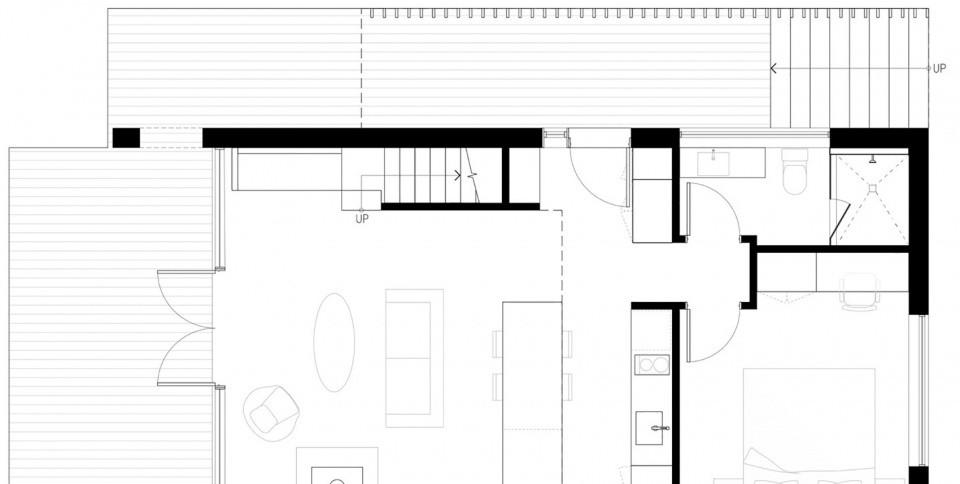
▼夹层平面图,mezzanine plan© Dubbeldam Architecture Design

▼剖面图,sections© Dubbeldam Architecture Design

